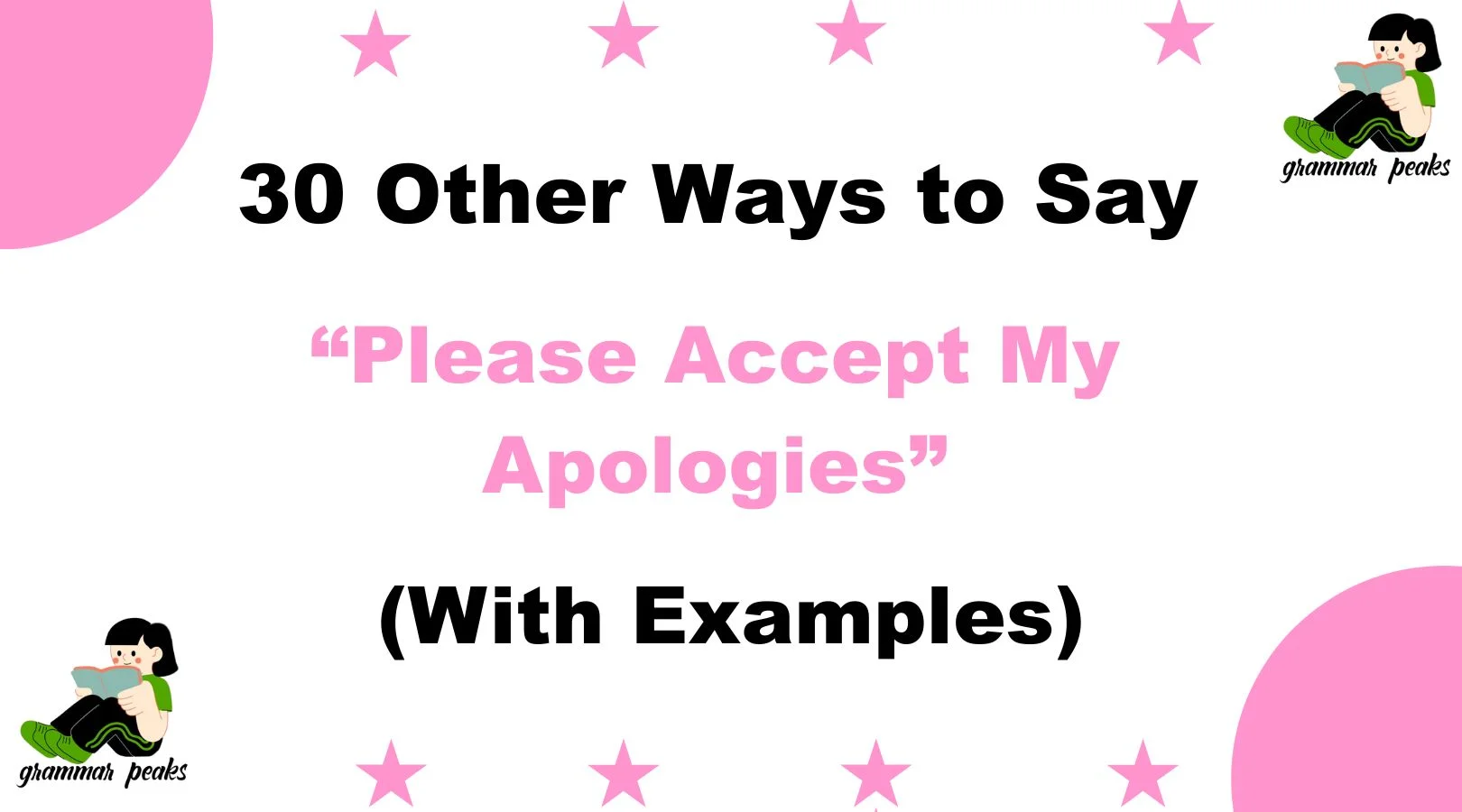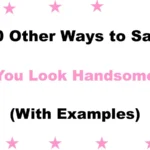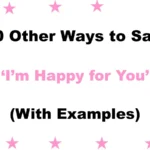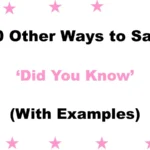Saying “Please accept my apologies” is often the go-to phrase when we need to express sincere regret—but sometimes, it can feel too formal or overused. Whether you’re writing a heartfelt message, addressing a colleague, or mending a personal relationship, using words that truly reflect your emotion makes a big difference.
The way we say sorry should reflect empathy, responsibility, and care. This guide offers 30 thoughtful alternatives to help you sound warm, authentic, and emotionally intelligent. Whether you’re aiming for professionalism or a softer tone, these expressions will help you say the right thing at the right time—with clarity and compassion.
What Does “Please Accept My Apologies” Mean?
The phrase “Please accept my apologies” is a formal and respectful way to acknowledge a mistake, express regret, and ask for forgiveness. It’s often used when someone wants to show that they take responsibility for their actions and value the feelings of the person they may have hurt or inconvenienced.
At its heart, the phrase is an invitation for the other person to recognize your remorse and hopefully move toward resolution or forgiveness. While it’s often heard in professional or polite settings, it can sometimes feel distant in more personal situations—prompting many to look for more heartfelt or emotionally resonant alternatives.
When to Use “Please Accept My Apologies”
Use this phrase when:
- You are addressing someone in a formal or professional context.
- The mistake or inconvenience is moderate to serious.
- You want to maintain etiquette while still showing remorse.
- A personal “I’m sorry” feels too casual or unstructured.
Avoid it when:
- You are talking to close friends or family.
- A more casual, warm tone is required.
Is It Polite or Professional to Say “Please Accept My Apologies”?
Yes, “Please accept my apologies” is both polite and professional, making it a suitable choice for formal conversations, business emails, or customer service situations. It conveys respect, accountability, and emotional maturity without sounding too casual or overly emotional. Because of its graceful tone and structured phrasing,
it’s often used in workplaces, official letters, or when addressing someone you don’t know personally. However, in personal relationships or emotionally charged situations, this phrase can sometimes feel a bit distant or impersonal—which is why many people opt for warmer, more heartfelt alternatives depending on the context.
Pros and Cons of Saying “Please Accept My Apologies”
Pros:
- Shows respect and politeness
- Appropriate for formal settings
- Reflects professionalism
Cons:
- Can feel impersonal or cold
- Lacks emotional depth
- May seem outdated in casual contexts
Synonyms for “Please Accept My Apologies”
- I’m truly sorry
- I apologize sincerely
- Please forgive me
- I didn’t mean to hurt you
- It was never my intention
- I regret what happened
- I take full responsibility
- I owe you an apology
- My sincerest apologies
- I’m sorry for letting you down
- I hope you can forgive me
- I deeply regret my actions
- Please don’t take it personally
- I realize I was wrong
- I want to make things right
- That was uncalled for—I’m sorry
- Please know I didn’t mean to hurt you
- I was out of line
- I misjudged the situation
- I didn’t handle that well
- That was thoughtless of me
- I regret not acting differently
- I didn’t mean for it to come out that way
- I was wrong, and I’m sorry
- I can see how that upset you
- I crossed a line—I’m sorry
- I shouldn’t have said that
- That was insensitive of me
- I want to earn back your trust
- I know this doesn’t fix it, but I’m sorry
1. I’m Truly Sorry
Definition: A heartfelt expression of remorse.
Explanation: Emphasizes sincerity and personal responsibility.
Scenario: “I’m truly sorry for forgetting your birthday—it slipped my mind.”
Best Use: Personal messages, emotional conversations.
Worst Use: Legal or business communication where formality is needed.
Tone: Warm, personal, genuine.
2. I Apologize Sincerely
Definition: A formal yet human way to say sorry.
Explanation: Combines direct apology with an emotional touch.
Scenario: “I apologize sincerely for the confusion during the presentation.”
Best Use: Professional emails with a hint of humility.
Worst Use: Informal chats—it may feel too rehearsed.
Tone: Formal yet compassionate.
3. Please Forgive Me
Definition: A vulnerable request for forgiveness.
Explanation: Asks for emotional understanding directly.
Scenario: “I know I hurt you, and I’m asking—please forgive me.”
Best Use: Emotional or intimate apologies.
Worst Use: Corporate or legal settings.
Tone: Vulnerable, emotional, honest.
4. I Regret What Happened
Definition: A reflective expression of remorse.
Explanation: Acknowledges the impact of your actions.
Scenario: “I regret what happened during our discussion—I was out of line.”
Best Use: Conflict resolution or post-argument reflection.
Worst Use: Quick apologies—it may feel too heavy.
Tone: Reflective, serious.
5. My Apologies
Definition: A brief and polite way to express regret.
Explanation: Ideal for small errors or minor inconveniences.
Scenario: “My apologies for the late reply—I’ve been tied up.”
Best Use: Business, emails, small misunderstandings.
Worst Use: Serious situations—it may feel dismissive.
Tone: Polite, brief.
6. I’m Sorry for the Inconvenience
Definition: An acknowledgment of the trouble caused.
Explanation: Good for customer service or public-facing roles.
Scenario: “I’m sorry for the inconvenience this issue has caused.”
Best Use: Business, customer relations.
Worst Use: Deep emotional issues—it may seem impersonal.
Tone: Professional, apologetic.
7. I Owe You an Apology
Definition: Takes ownership of wrongdoing.
Explanation: Signals responsibility and humility.
Scenario: “I owe you an apology—I misjudged the situation.”
Best Use: Honest conversations, accountability.
Worst Use: Formal contexts.
Tone: Honest, vulnerable.
8. I Take Full Responsibility
Definition: Strong statement of accountability.
Explanation: Great for leadership or serious issues.
Scenario: “I take full responsibility for what happened during the project.”
Best Use: Leadership, management roles, PR.
Worst Use: Casual apologies.
Tone: Serious, accountable.
9. That Was My Fault
Definition: A simple admission of guilt.
Explanation: Shows you’re not making excuses.
Scenario: “That was my fault—I didn’t double-check the info.”
Best Use: Personal or team communication.
Worst Use: Highly formal settings.
Tone: Casual, honest.
10. I’m Sorry, I Messed Up
Definition: Informal way to admit a mistake.
Explanation: Expresses regret with vulnerability.
Scenario: “I’m sorry—I messed up and I know it.”
Best Use: Friends, partners, or close teams.
Worst Use: Corporate environments.
Tone: Informal, honest.
11. I Hope You Can Forgive Me
Definition: A gentle way to express remorse and ask for grace.
Explanation: Invites the other person to move forward without pressure.
Scenario: “I hope you can forgive me for not being there when you needed me.”
Best Use: Personal relationships, emotional situations.
Worst Use: Business or legal settings.
Tone: Soft, humble, hopeful.
12. I Deeply Regret My Actions
Definition: Strong expression of sorrow and accountability.
Explanation: Shows you’ve reflected deeply on the impact of your behavior.
Scenario: “I deeply regret my actions and how they affected our team.”
Best Use: Serious apologies, formal or leadership contexts.
Worst Use: Everyday small slip-ups.
Tone: Formal, sincere, weighty.
13. Please Don’t Take It Personally
Definition: Apology paired with emotional reassurance.
Explanation: Attempts to smooth over tension or misunderstanding.
Scenario: “Please don’t take it personally—I didn’t mean to sound dismissive.”
Best Use: Interpersonal or workplace miscommunications.
Worst Use: When accountability is needed—it may seem dismissive.
Tone: Softening, diplomatic.
14. I Realize I Was Wrong
Definition: Honest admission of fault.
Explanation: Acknowledges error with emotional maturity.
Scenario: “I realize I was wrong to assume what you needed.”
Best Use: Personal growth, vulnerable moments.
Worst Use: Legal or professional contexts needing distance.
Tone: Transparent, humble.
15. I Want to Make Things Right
Definition: Expresses both regret and willingness to take action.
Explanation: Goes beyond an apology to signal corrective steps.
Scenario: “I want to make things right—let’s talk about how I can fix this.”
Best Use: Personal and professional contexts involving repair.
Worst Use: Quick or casual settings.
Tone: Proactive, restorative.
16. That Was Uncalled For—I’m Sorry
Definition: A specific apology for inappropriate behavior.
Explanation: Shows recognition of crossing a line.
Scenario: “That was uncalled for—I’m sorry I snapped at you.”
Best Use: Conflict resolution.
Worst Use: Formal or written settings.
Tone: Candid, direct.
17. Please Know I Didn’t Mean To Hurt You
Definition: Apology combined with clarification of intent.
Explanation: Balances regret with explanation.
Scenario: “Please know I didn’t mean to hurt you with my words.”
Best Use: Relationships, sensitive topics.
Worst Use: Where impact matters more than intent.
Tone: Emotional, gentle.
18. I Was Out of Line
Definition: Admission of inappropriate behavior or tone.
Explanation: Acknowledges a boundary was crossed.
Scenario: “I was out of line to speak to you that way—I’m sorry.”
Best Use: Heated discussions, tense workplace moments.
Worst Use: Mild slip-ups or formal writing.
Tone: Honest, apologetic.
19. I Misjudged the Situation
Definition: Apology for misunderstanding or misreading.
Explanation: Demonstrates thoughtful self-reflection.
Scenario: “I misjudged the situation and made the wrong call.”
Best Use: Team dynamics, leadership contexts.
Worst Use: Emotional apologies—it may sound too technical.
Tone: Reflective, rational.
20. I Didn’t Handle That Well
Definition: Owning a poor response or decision.
Explanation: Admits the error without excuses.
Scenario: “I didn’t handle that well—I should have listened more.”
Best Use: Relationship conflicts, workplace feedback.
Worst Use: Where precise accountability is needed.
Tone: Honest, constructive.
21. That Was Thoughtless of Me
Definition: Admitting carelessness or lack of consideration.
Explanation: Shows awareness of impact and emotional regret.
Scenario: “It was thoughtless of me not to check in—I’m sorry.”
Best Use: Emotional or empathetic conversations.
Worst Use: Corporate or formal settings.
Tone: Regretful, heartfelt.
22. I Regret Not Acting Differently
Definition: Looking back with emotional remorse.
Explanation: Expresses a desire to have behaved better.
Scenario: “I regret not acting differently during your time of need.”
Best Use: Apologies in personal reflection.
Worst Use: Brief or casual missteps.
Tone: Reflective, emotional.
23. I Didn’t Mean for It to Come Out That Way
Definition: Acknowledge miscommunication, not ill intent.
Explanation: Useful for tone-related misunderstandings.
Scenario: “I didn’t mean for it to come out that way—I was just stressed.”
Best Use: Tone or language missteps.
Worst Use: Serious actions or offenses.
Tone: Casual, clarifying.
24. I Was Wrong, and I’m Sorry
Definition: Clear admission with heartfelt apology.
Explanation: Combines emotional honesty with directness.
Scenario: “I was wrong, and I’m sorry for how I treated you.”
Best Use: Trust rebuilding, personal healing.
Worst Use: Legal or HR contexts.
Tone: Sincere, straightforward.
25. I Can See How That Upset You
Definition: Acknowledges the other person’s feelings.
Explanation: Centers empathy without immediately excusing.
Scenario: “I can see how that upset you—and I’m truly sorry.”
Best Use: Emotional damage or relational tension.
Worst Use: Objective or detached contexts.
Tone: Empathetic, validating.
26. I Crossed a Line—I’m Sorry
Definition: Admits going too far in words or actions.
Explanation: Shows understanding of overstepping.
Scenario: “I crossed a line with that comment—I’m sorry.”
Best Use: Heated arguments or reactive behavior.
Worst Use: Mild mistakes.
Tone: Direct, remorseful.
27. I Shouldn’t Have Said That
Definition: Recognizes harmful words.
Explanation: Useful for moments when communication caused hurt.
Scenario: “I shouldn’t have said that—I was frustrated.”
Best Use: Apologies for verbal missteps.
Worst Use: Broader situations needing full accountability.
Tone: Regretful, personal.
28. That Was Insensitive of Me
Definition: Acknowledges emotional insensitivity.
Explanation: Good for overlooked emotional needs.
Scenario: “It was insensitive of me to make that joke—I’m really sorry.”
Best Use: Apologizing for tone-deafness.
Worst Use: Legal/HR responses.
Tone: Apologetic, empathetic.
29. I Want to Earn Back Your Trust
Definition: Expresses desire for long-term repair.
Explanation: Goes beyond apology to offer commitment.
Scenario: “I know I hurt you—I want to earn back your trust.”
Best Use: Deep emotional wounds, relationships.
Worst Use: Casual or brief apologies.
Tone: Loyal, serious, restorative.
30. I Know This Doesn’t Fix It, But I’m Sorry
Definition: Acknowledge that words may not be enough.
Explanation: Balances humility with heartfelt apology.
Scenario: “I know this doesn’t fix it, but I’m truly sorry for what I did.”
Best Use: Deep or emotional wrongdoings.
Worst Use: Formal communications.
Tone: Humble, genuine, emotional.
Conclusion
Saying “Please accept my apologies” is a fine choice—but it’s not your only one. Depending on the situation, a warmer, more human way of saying sorry can make all the difference. Whether you’re aiming to rebuild trust, express empathy, or simply take responsibility, the right words can heal, restore, and reconnect.
By choosing alternatives that reflect your tone, audience, and intention, you show not just remorse—but emotional maturity and compassion. Use this list as your go-to guide for thoughtful, caring communication—and never be at a loss for sincere words again.
FAQs
1. What is a more heartfelt way to say “Please accept my apologies”?
A more heartfelt way could be something like “I truly regret how that happened and I want to make it right” or “I know I hurt you, and I’m deeply sorry.” These alternatives sound more human and emotionally genuine, which can help you connect better with the person you’re addressing.
2. Is “Please accept my apologies” still professional to use?
Yes, it is still polite and professional, especially in formal emails or business communication. However, if you’re looking to sound more genuine or empathetic, alternatives like “I regret the inconvenience” or “I take full responsibility” may come across as more thoughtful and personal.
3. When should I avoid using “Please accept my apologies”?
Avoid using it when the situation calls for emotional vulnerability or when the phrase feels too detached or formulaic. For example, in close relationships or sensitive emotional moments, saying “I know I was wrong, and I’m sorry” may feel more authentic.
4. How can I apologize without sounding too formal?
You can soften the tone with phrases like “I didn’t mean to hurt you”, “That was my mistake”, or “I didn’t handle that well.” These sound more natural and conversational while still being respectful and sincere.
5. Can I use these alternatives in professional emails?
Absolutely! Just choose those with a more measured and respectful tone, such as:
- “I regret the oversight.”
- “Please allow me to make it right.”
- “That was an error on my part.”
These strike a balance between professionalism and warmth, perfect for workplace settings.






